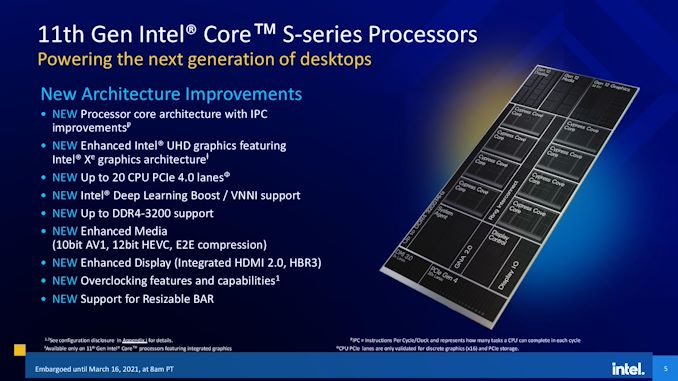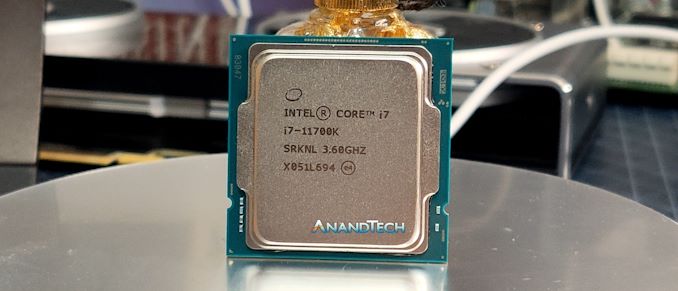
In the myriad of news and early evaluations, Intel is today formally introducing its 11 th Generation Core household of desktop processors, likewise called Rocket Lake, developed on Intel’s most sophisticated 14nm procedure node innovation. This brand-new item household will form the basis of Intel’s premium desktop portfolio for the majority of 2021, if not longer, and includes processors with as much as 8 cores. Emphasizes consist of the brand-new microarchitecture, Cypress Cove, and the Xe-LP graphics style, both of which are redesigns of Intel’s 10nm mobile items. These parts likewise consist of Intel’s very first PCIe 4.0 offering on the desktop, brand-new AVX-512 for desktop, much better memory assistance, assistance for resizable BAR, brand-new overclocking functions, and boosted multimedia velocity.
To The Moon With Rocket Lake
With Intel’s desktop processor launches, we usually observe that the brand-new household is all prevalent, making it possible for items from the leading Core i9 or i7 parts, all the method to the Pentiums and the Celerons. Intel generally accomplishes this by constructing one, 2, or more various sizes of silicon, frequently varying in cores and graphics to attain the ideal balance of expense, yield, and efficiency.
For this generation, Intel has actually chosen to just produce one size of silicon, and section its offering, with the brand-new household just being utilized for Core i5 and up.
This one-size silicon style includes 8 of Intel’s brand-new Cypress Cove cores, with HyperThreading, and 32 execution systems of ‘Gen 12’ graphics, originated from Intel’s latest Xe-LP graphics styles. Likewise bundled because silicon is a DDR4-3200 memory controller, a PCIe 4.0 root intricate offering 20 lanes for discrete graphics and storage, a double width DMI x8 link to the chipset, advanced AVX-512 assistance for Intel’s Deep Knowing Increase innovations, upgraded overclocking, and next-generation media and show velocity.
In the past, Intel’s Tick-Tock method implied that in each item cycle, either the procedure node would be upgraded (tick), or the microarchitecture would be upgraded (tock). The brand-new Rocket Lake processors, with the Cypress Cove core, falls quite under the ‘tock’ classification, nevertheless this core isn’t a totally brand-new microarchitecture by the meaning of the word ‘brand-new’.
Backporting 14nm to 10nm
In order to allow Cypress Cove, Intel has actually taken its Sunny Cove core style developed on 10nm, and re-architected it for 14nm. The procedure of doing this is what Intel created as a ‘backport’. The procedure of backporting isn’t as simple as putting the core style on a copy machine and making it bigger– the result of the physics of electrons going through wires suggests that there are some intrinsic style urgencies because procedure which deviate it a little. However on the whole, as our screening has actually currently revealed on our retail samples, regardless of the conversations about power, Intel has actually handled to keep 14nm Cypress Cove as near the initial 10nm Sunny Cove style as possible.
In a comparable mantra, the brand-new Xe-LP ‘Gen12’ graphics on Rocket Lake is likewise a comparable backport. This time Intel has actually taken the graphics subsystem from its 10nm Tiger Lake note pad processors and crafted it into 14nm. As a note pad processor Tiger Lake focuses a lot on integrated graphics, and as an outcome has 96 execution systems– Rocket Lake by contrast has just 32 systems.
Backport vs Co-design
The future of how and when Intel will start extra backporting, even given suggested roadmaps, is most likely to be in flux based upon its capability to produce high single-core frequency desktop processors. Cypress Cove, by many steps, is a reflex action to an expanding space in Intel’s desktop roadmap, and takes a core particularly developed for a various procedure. Intel is/has/has most likely discovered a lot from this procedure, however in the future we can anticipate particular cores to be co-designed with both procedure nodes in mind. This belongs to Intel’s brand-new position on ‘making it possible for the ideal item on the ideal node at the correct time’. A co-designed method, instead of a post-production realisation a backport is needed, will imply that future core styles that straddle 2 procedure nodes are most likely to be more comparable and enhanced on both procedures at the exact same time.
Rocket Lake: Core i9, Core i7, Core i5
The brand-new Intel 11 th Gen Core desktop processor household will begin with Core i5, with 6 cores and twelve threads, through to Core i7 and Core i9, both with 8 cores and sixteen threads. All processors will support DDR4-3200 natively, and deal 20 PCIe 4.0 lanes in supported motherboards– these lanes will allow graphics and storage direct from the processor, usually in an x16/x4 or x8/x8/x4 mix.
Both the Core i9 and Core i7 this time around have the exact same core count – generally the Core i9 would use an apparent distinction, such as more cores, however for this generation the distinction is more subtle: Core i9 will use greater frequencies and thermal speed increase (TVB).
| Intel 11th Gen Core Rocket Lake Core i9 |
|||||||
| AnandTech | Cores Threads |
Base Freq |
1T Peak |
nT Turbo |
TDP ( W) |
IGP UHD |
Rate 1ku |
| i9-11900K | 8/ 16 | 3500 | 5300 | 4700 | 125 | 750 | $ 539 |
| i9-11900KF | 8/ 16 | 3500 | 5300 | 4700 | 125 | – | $ 513 |
| i9-11900 | 8/ 16 | 2500 | 5200 | 4600 | 65 | 750 | $ 439 |
| i9-11900F | 8/ 16 | 2500 | 5200 | 4600 | 65 | – | $ 422 |
| i9-11900T | 8/ 16 | 1500 | 4900 | 3700 | 35 | 750 | $ 439 |
At the top of the stack is the Core i9-11900K. Intel has actually set the 1000-unit prices of the Core i9-11900K at $539. Keep in mind that Intel does this 1k system prices for OEMs, so the last list price is frequently $10-$ 25 greater. This is well above AMD’s Ryzen 7 5800X at $449 SEP (MSRP), which is likewise an 8-core processor. Intel is specifying that together with much better video gaming efficiency, this processor likewise provides next-generation integrated graphics, assistance for brand-new AI guidelines, and boosted media assistance for the rate differential.
On specs, we understood the majority of the Core i9-11900K from a previous statement, however today we discover that this processor has a base frequency of 3.5 GHz, together with a peak turbo of 5.3 GHz in Thermal Speed Increase mode, 5.2 GHz otherwise on the preferred core, or 5.1 GHz on non-favored cores. The all-core frequency is 4.8 GHz in TVB turbo mode, or 4.7 GHz otherwise.
Thermal Speed Increase is rather brand-new to the desktop area, however what it suggests is that if the processor is under a specific temperature level, it will include an extra +100 MHz frequency throughout turbo. When it comes to the desktop processors, this temperature level is 70ºC (158F). That being stated, motherboard producers are totally free to disregard this temperature level, and in our experience, nearly all consumer/gaming motherboards disable that check and enable TVB at all temperature levels.
The only processor not getting TVB in the Core i9 household is the i9-11900T, which is the 35 W family member. This processor has 35 W on package since its base frequency is 1.5 GHz, although it will turbo as much as 4.9 GHz single core and 3.7 GHz all-core. These T processors usually wind up in OEM systems and mini-PCs which are most likely to strictly follow Intel’s turbo suggestions.
All Core i9 processors will support DDR4-3200, and the spec is that the K/KF processors allow a 1:1 frequency mode with the memory controller at this speed, whereas the non K/KF perform at 2:1 at DDR4-3200, or 1:1 at DDR4-2933 ( more on this later).
| Intel 11th Gen Core Rocket Lake Core i7 |
|||||||
| AnandTech | Cores Threads |
Base Freq |
1T Peak |
nT Turbo |
TDP ( W) |
IGP UHD |
Rate 1ku |
| i7-11700K | 8/ 16 | 3600 | 5000 | 4600 | 125 | 750 | $ 399 |
| i7-11700KF | 8/ 16 | 3600 | 5000 | 4600 | 125 | – | $ 374 |
| i7-11700 | 8/ 16 | 2500 | 4900 | 4400 | 65 | 750 | $ 323 |
| i7-11700F | 8/ 16 | 2500 | 4900 | 4400 | 65 | – | $ 298 |
| i7-11700T | 8/ 16 | 1400 | 4600 | 3600 | 35 | 750 | $ 323 |
The Core i7 household consists of the Core i7-11700K, which we have already reviewed with our retail sample, and evaluated on the current microcode to date. This processor provides 8 cores, sixteen threads, with a single core turbo of 5.0 GHz on the preferred core, 4.9 GHz otherwise, and 4.6 GHz all-core turbo.
As kept in mind in our evaluation, the 125 W TDP on package suggests bit, as we saw 215-225 W peak power draw throughout turbo of AVX2, and 276-292 W peak power draw throughout AVX-512, and motherboard producers frequently default to unrestricted turbo in any occasion. Users pursuing any Core i7 or Core i9 item ought to want to an excellent air cooler or liquid cooler to get the very best thermal efficiency here.
On the subject of memory assistance, the Core i7 household does support DDR4-3200, nevertheless Intel’s specs is that any non-Core i9 processor ought to perform at a 2:1 ratio of DRAM to memory controller by default, instead of 1:1, efficiently decreasing memory efficiency. This develops some division in between Core i9 and the rest, when it comes to the remainder of the processors the spec for DDR4-2933 is 1:1. In spite of this technical spec, we can validate in our screening of our Core i7-11700K that all the motherboards we have actually utilized up until now really default to 1:1 at DDR4-3200. It would appear that motherboard producers are positive enough in their memory creates to disregard Intel’s specs on this.
On prices, the Intel Core i7-11700K is $399, which is necessary in 2 methods.
Initially, it is $140 less expensive than the Core i9-K, for the sake of just a couple of hundred MHz. That leaves the Core i9 high and dry on the first day. Unless there’s something unique because chip we have not been outlined that we need to find come retail day on March 30 th, that’s a huge prices distinction.
2nd is the relative AMD processor, the Ryzen 7 5800X, which has 8 cores and has a $449 SEP. If both processors were discovered at these costs, then the contrast is an excellent one– the Ryzen 7 5800X in our screening scored +8% in CPU tests and +1% in video gaming tests (1080p Max). The Ryzen is quite the more effective processor, nevertheless the Intel has actually incorporated graphics (an argument that vanishes with KF at $374). It will be fascinating to see what suggestions individuals concern with that prices.
| Intel 11th Gen Core Rocket Lake Core i5 |
|||||||
| AnandTech | Cores Threads |
Base Freq |
1T Peak |
nT Turbo |
TDP ( W) |
IGP UHD |
Rate 1ku |
| i5-11600K | 6/ 12 | 3900 | 4900 | 4600 | 125 | 750 | $ 262 |
| i5-11600KF | 6/ 12 | 3900 | 4900 | 4600 | 125 | – | $ 237 |
| i5-11600 | 6/ 12 | 2800 | 4800 | 4300 | 65 | 750 | $ 213 |
| i5-11600T | 6/ 12 | 1700 | 4100 | 3500 | 35 | 750 | $ 213 |
| i5-11500 | 6/ 12 | 2700 | 4600 | 4200 | 65 | 750 | $ 192 |
| i5-11500T | 6/ 12 | 1500 | 3900 | 3400 | 35 | 750 | $ 192 |
| i5-11400 | 6/ 12 | 2600 | 4400 | 4200 | 65 | 730 | $ 182 |
| i5-11400F | 6/ 12 | 2600 | 4400 | 4200 | 65 | – | $ 157 |
| i5-11400T | 6/ 12 | 1300 | 3700 | 3300 | 35 | 730 | $ 182 |
Another distinction within these parts is that the Core i5-11400 and Core i5-11400T have UHD Graphics 730, not 750, which most likely suggests that these are running 16 EU setups, instead of 32 EU. The Core i5 expands a lot with more offerings, from $157 for the Core i5-11400F, as much as $262 for the Core i5-11600K. All these processors have 6 cores and twelve threads, all have the conventional Intel Turbo 2.0, and all assistance DDR4-3200 (2:1) or DDR4-2933 (1:1).
Comet Lake Refresh: Core i3, Pentium
Instead of develop a smaller sized piece of silicon on Cypress cove for the quad-core parts and listed below, Intel has actually chosen to dust off the previous generation style and offer it some upgraded frequencies. This suggests that none of the Cypress Cove enhancements remain in these parts, it is merely Skylake revitalized for a 6th model.
Whatever here is still called 10 th Gen, and it goes up +100 MHz or so compared to the routine Comet Lake parts. The refresh designs are provided the ‘5’ classification on completion.
| Intel 10th Gen Core Comet Lake Refresh Core i3, Pentium |
||||||||
| AnandTech | Cores Threads |
Base Freq |
1T Peak |
nT Turbo |
L3 MB |
TDP ( W) |
IGP UHD |
Rate 1ku |
| i3-10325 | 4/ 8 | 3900 | 4700 | 4500 | 8 | 65 | 630 | $ 154 |
| i3-10305 | 4/ 8 | 3800 | 4500 | 4300 | 8 | 65 | 630 | $ 143 |
| i3-10305T | 4/ 8 | 3000 | 4000 | 3700 | 8 | 35 | 630 | $ 143 |
| i3-10105 | 4/ 8 | 3700 | 4400 | 4200 | 6 | 65 | 630 | $ 122 |
| i3-10105F | 4/ 8 | 3700 | 4400 | 4200 | 6 | 65 | – | $ 97 |
| i3-10105T | 4/ 8 | 3000 | 3900 | 3600 | 6 | 35 | 630 | $ 122 |
| Gold G6605 | 2/ 4 | 4300 | – | – | 4 | 65 | 630 | $ 86 |
| Gold G6505 | 2/ 4 | 4200 | – | – | 4 | 65 | 630 | $ 75 |
| Gold G6505T | 2/ 4 | 3600 | – | – | 4 | 35 | 630 | $ 75 |
| Gold G6405 | 2/ 4 | 4100 | – | – | 4 | 65 | 610 | $ 64 |
| Gold G6405T | 2/ 4 | 3500 | – | – | 4 | 35 | 610 | $ 64 |
The crucial part in this household has actually constantly been the Core i3-10105F, using a quad core processor comparable to the Core i7-7700K for under $100.
On the next page, we go over motherboard assistance, and the brand-new overclocking functions.











